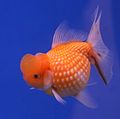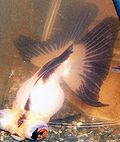| Common goldfish
|
Black Moor
|
Bubble Eye
|
| Common goldfish differ only in color from their closest relative, the Prussian carp. Common goldfish come in a variety of colors including red, orange/gold, white, black and yellow or 'lemon' goldfish.
|

|
The Black moor is a telescope-eyed variety of fancy goldfish that has a characteristic pair of protruding eyes. It is also referred to as popeye, telescope, kuro demekin in Japan and dragon-eye in China.
|

|
The small, fancy Bubble Eye has upward pointing eyes accompanied by two large fluid-filled sacs.
|

|
| Celestial Eye
|
Comet (goldfish)
|
Fantail (goldfish)
|
| Fancy Celestial eye goldfish or Choten gan has a double tail and a breed-defining pair of upturned, telescope eyes with pupils gazing skyward.
|

|
The comet or comet-tailed goldfish is the most common fancy variety in the United States. It is similar to the common goldfish, except slightly smaller and slimmer, and is mainly distinguished by its long, deeply forked tail.
|
File:Sarasa comet goldfish.jpg
|
The Fantail goldfish is the western form of the Ryukin and possesses an egg-shaped body, a high dorsal fin, a long quadruple caudal fin, and no shoulder hump.
|

|
| Lionhead (goldfish)
|
Oranda
|
Pearlscale
|
| The fancy lionhead has a hood. This fish is the precursor to the ranchu.
|

|
The fancy oranda is characterized by a prominent raspberry-like hood or (also known as wen or headgrowth) that encases the whole head except for the eyes and mouth.
|

|
The fancy pearlscale or chinshurin in Japanese, is spherical-bodied with finnage similar to the fantail.
|

|
| Pompom (goldfish)
|
Ryukin
|
Shubunkin
|
| The fancy Pompoms or pompon or hana fusa have bundles of loose fleshy outgrowths between the nostrils, on each side of the head.
|
|
The fancy ryukin has a short, deep body with a characteristic shoulder hump.
|

|
Fancy and hardy Japanese Shubunkins (朱文金?) (translated literally as "red brocade") have a single tail with nacreous scales, and a pattern known as calico.
|

|
| Telescope eye
|
Ranchu
|
Panda Moor
|
| The fancy telescope eye or demekin is characterized by its protruding eyes. It is also known as globe eye or dragon eye goldfish.
|

|
The fancy Japanese ranchu is hooded. The Japanese refer to it as the "king of goldfish".
|

|
The fancy panda moor has a characteristic black-and-white color pattern and protruding eyes.
|

|
| Veiltail
|
Butterfly tail (goldfish)
|
Meteor goldfish
|
| The fancy veiltail is known for its extra-long, flowing double tail. Modern veiltail standards require little or no indentation of the trailing edges of the caudal fins, as in a wedding veil for a bride.
|

|
The Butterfly Tail Moor or Butterfly Telescope is of the telescope-eye lineage, with twin tails best viewed from above. The spread of the caudal fins mimics butterflies underwater.
|

|
The Meteor goldfish is a strange-looking variety that has been developed by specialist breeders of fancy goldfish. It has no tail fin, hence its name.[1][2]
|
| Lionchu
|
Egg-fish goldfish
|
Shukin
|
| The Lionchu or lionhead-ranchu is a fancy goldfish that has resulted from crossbreeding lionheads and ranchus.[3][4]
|

|
The egg-fish goldfish is an artificial creation of specialist fancy goldfish breeders which lacks a dorsal fin and has a pronounced egg-shaped body.[5][6]
|

|
The Shukin is Ranchu-like goldfish developed from Ranchu and Oranda at the end of the 19th century in Japan.
|
|
| Curled-gill goldfish
|
Tamasaba
|
Tosakin
|
| The Curled-gill or Reversed-gill goldfish is another uncommon variety of fancy goldfish that has been developed by specialist enthusiasts. It owes its name to the out-turned appearance of its gill covers.[2][7]
|

|
The Tamasaba or Sabao is an uncommon Japanese variety of goldfish with a body shaped similar to the Ryukin and a very long, flowing, single tail that is similar to that of a mackerel, hence its other name, Mackerel Tail.
|
|
The Tosakin or curly fantail goldfish is a very distinctive breed of goldfish with a large tail fin that spreads out horizontally (like a fan) behind the fish. Though technically a divided tail, the two halves are attached at the center/middle forming a single fin.
|

|


















